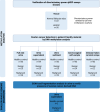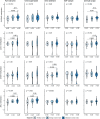Molecular analysis for ovarian cancer detection in patient-friendly samples
- PMID: 38755429
- PMCID: PMC11099128
- DOI: 10.1038/s43856-024-00517-8
Molecular analysis for ovarian cancer detection in patient-friendly samples
Abstract
Background: High ovarian cancer mortality rates motivate the development of effective and patient-friendly diagnostics. Here, we explored the potential of molecular testing in patient-friendly samples for ovarian cancer detection.
Methods: Home-collected urine, cervicovaginal self-samples, and clinician-taken cervical scrapes were prospectively collected from 54 patients diagnosed with a highly suspicious ovarian mass (benign n = 25, malignant n = 29). All samples were tested for nine methylation markers, using quantitative methylation-specific PCRs that were verified on ovarian tissue samples, and compared to non-paired patient-friendly samples of 110 age-matched healthy controls. Copy number analysis was performed on a subset of urine samples of ovarian cancer patients by shallow whole-genome sequencing.
Results: Three methylation markers are significantly elevated in full void urine of ovarian cancer patients as compared to healthy controls (C2CD4D, P = 0.008; CDO1, P = 0.022; MAL, P = 0.008), of which two are also discriminatory in cervical scrapes (C2CD4D, P = 0.001; CDO1, P = 0.004). When comparing benign and malignant ovarian masses, GHSR shows significantly elevated methylation levels in the urine sediment of ovarian cancer patients (P = 0.024). Other methylation markers demonstrate comparably high methylation levels in benign and malignant ovarian masses. Cervicovaginal self-samples show no elevated methylation levels in patients with ovarian masses as compared to healthy controls. Copy number changes are identified in 4 out of 23 urine samples of ovarian cancer patients.
Conclusions: Our study reveals increased methylation levels of ovarian cancer-associated genes and copy number aberrations in the urine of ovarian cancer patients. Our findings support continued research into urine biomarkers for ovarian cancer detection and highlight the importance of including benign ovarian masses in future studies to develop a clinically useful test.
Plain language summary
Ovarian cancer is often found late with limited treatment options. Currently, it is difficult to diagnose ovarian cancer correctly and no recommended early detection or screening methods exist. Our aim was to explore the use of DNA-based tests in patient-friendly samples for ovarian cancer detection. Patient-friendly samples are patient materials that can be collected from home without pain or discomfort, such as self-collected vaginal swabs and urine. Using DNA-based tests, we found that urine of women with ovarian cancer contains ovarian cancer-associated signals. Our findings encourage further development of a potential urine test for ovarian cancer detection. This approach could aid early detection and guide women with ovarian masses to appropriate specialist care.
© 2024. The Author(s).
Conflict of interest statement
R.D.M.S. is a minority shareholder of Self-screen BV. The remaining authors declare no competing interests.
Figures



Similar articles
-
DNA methylation testing for endometrial cancer detection in urine, cervicovaginal self-samples and cervical scrapes.Int J Cancer. 2023 Jul 15;153(2):341-351. doi: 10.1002/ijc.34504. Epub 2023 Mar 23. Int J Cancer. 2023. PMID: 36912267
-
Bladder cancer detection in urine using DNA methylation markers: a technical and prospective preclinical validation.Clin Epigenetics. 2022 Feb 5;14(1):19. doi: 10.1186/s13148-022-01240-8. Clin Epigenetics. 2022. PMID: 35123558 Free PMC article.
-
Cervical cancer detection by DNA methylation analysis in urine.Sci Rep. 2019 Feb 28;9(1):3088. doi: 10.1038/s41598-019-39275-2. Sci Rep. 2019. PMID: 30816167 Free PMC article.
-
First-void urine: A potential biomarker source for triage of high-risk human papillomavirus infected women.Eur J Obstet Gynecol Reprod Biol. 2017 Sep;216:1-11. doi: 10.1016/j.ejogrb.2017.06.036. Epub 2017 Jun 27. Eur J Obstet Gynecol Reprod Biol. 2017. PMID: 28689156 Review.
-
Minimally Invasive and Emerging Diagnostic Approaches in Endometrial Cancer: Epigenetic Insights and the Promise of DNA Methylation.Diagnostics (Basel). 2024 Nov 15;14(22):2575. doi: 10.3390/diagnostics14222575. Diagnostics (Basel). 2024. PMID: 39594241 Free PMC article. Review.
Cited by
-
Epigenetic and Genomic Hallmarks of PARP-Inhibitor Resistance in Ovarian Cancer Patients.Genes (Basel). 2024 Jun 7;15(6):750. doi: 10.3390/genes15060750. Genes (Basel). 2024. PMID: 38927686 Free PMC article.
-
Unlocking the potential of tumor-derived DNA in urine for cancer detection: methodological challenges and opportunities.Mol Oncol. 2025 Jul;19(7):1918-1934. doi: 10.1002/1878-0261.13628. Epub 2024 Mar 10. Mol Oncol. 2025. PMID: 38462745 Free PMC article. Review.
References
-
- Sung H, et al. Global Cancer Statistics 2020: GLOBOCAN estimates of incidence and mortality worldwide for 36 cancers in 185 countries. CA: Cancer J. Clin. 2021;71:209–249. - PubMed
LinkOut - more resources
Full Text Sources
Research Materials

